| Listing 1 - 10 of 10 |
Sort by
|
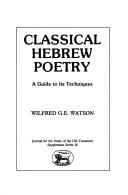
ISBN: 0905774574 0567540898 9786611802431 1281802433 0567434168 9780905774572 9781281802439 9780567434166 Year: 1984 Volume: 26 Publisher: Sheffield, England : JSOT Press, Dept. of Biblical Studies, University of Sheffield,
Abstract | Keywords | Export | Availability | Bookmark
 Loading...
Loading...Choose an application
- Reference Manager
- EndNote
- RefWorks (Direct export to RefWorks)
In spite of debatable issues, such as metre, we now know enough about classical Hebrew poetry to be able to understand how it was composed. This large-scale manual, rich in detail, exegesis and bibliography, provides guidelines for the analysis and appreciation of Hebrew verse. Topics include oral poetry, metre, parallelism and forms of the strophe and stanza. Sound patterns and imagery are also discussed. A lengthy chapter sets out a whole range of other poetic devices and the book closes with a set of worked examples of Hebrew poetry.
Hebrew poetry, Biblical --- History and criticism --- #gsdb1 --- 223 --- 221.02*1 --- -221.02*1 Oud Testament: bijbelse filologie: hebreeuws --- Oud Testament: bijbelse filologie: hebreeuws --- Poëtische boeken van het Oude Testament --- 221.02*1 Oud Testament: bijbelse filologie: hebreeuws --- Hebrew poetry --- History and criticism. --- Hebrew poetry, Biblical - History and criticism
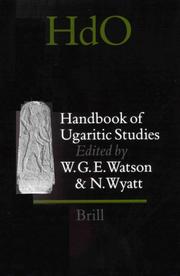
ISSN: 01699423 01699423 ISBN: 9004109889 9004294104 9789004109889 9789004294103 Year: 1999 Volume: 39 Publisher: Boston Brill
Abstract | Keywords | Export | Availability | Bookmark
 Loading...
Loading...Choose an application
- Reference Manager
- EndNote
- RefWorks (Direct export to RefWorks)
Over the past seven decades, the scores of publications on Ugarit in Northern Syria (15th to 11th centuries BCE) are so scattered that a good overall view of the subject is virtually impossible. Wilfred Watson and Nicolas Wyatt, the editors of the present Handbook in the series Handbook of Oriental Studies, have brought together and made accessible this accumulated knowledge on the archives from Ugarit, called 'the foremost literary discovery of the twentieth century' by Cyrus Gordon. In 16 chapters a careful selection of specialists in the field deal with all important aspects of Ugarit, such as the discovery and decipherment of a previously unknown script (alphabetic cuneiform) used to write both the local language (Ugaritic) and Hurrian and its grammar, vocabulary and style; documents in other languages (including Akkadian and Hittite), as well as the literature and letters, culture, economy, social life, religion, history and iconography of the ancient kingdom of Ugarit. A chapter on computer analysis of these documents concludes the work. This first such wide-ranging survey, which includes recent scholarship, an extensive up-to-date bibliography, illustrations and maps, will be of particular use to those studying the history, religion, cultures and languages of the ancient Near East, and also of the Bible and to all those interested in the background to Greek and Phoenician cultures.
Cuneiform inscriptions, Ugaritic --- Ugaritic philology --- Inscriptions cunéiformes ougaritiques --- Philologie ougaritique --- Ugarit (Extinct city) --- Ougarit (Ville ancienne) --- Cuneiform inscriptions, Ugaritic. --- Ugaritic philology. --- 809.25 --- 939.43 --- Ugaritic cuneiform inscriptions --- Ugaritisch --- History Ancient world Syria to 640 --- Ougarit (Extinct city) --- Raʼs Shamrah (Syria) --- Ras Shamra (Syria) --- Ugarit (Ancient city) --- Syria --- Antiquities --- 809.25 Ugaritisch --- Inscriptions cunéiformes ougaritiques
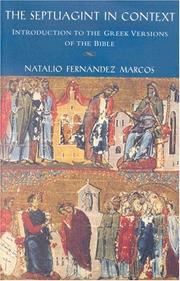
ISBN: 0391041096 9780391041097 Year: 2001 Publisher: Leiden: Brill,
Abstract | Keywords | Export | Availability | Bookmark
 Loading...
Loading...Choose an application
- Reference Manager
- EndNote
- RefWorks (Direct export to RefWorks)
Bible. --- Versions. --- Bible --- Versions --- Septuagint
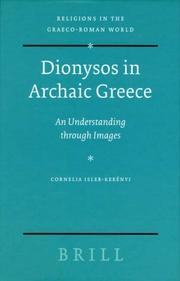
ISSN: 09277633 ISBN: 9789047418825 9047418824 9004144455 9789004144453 9786613060266 1283060264 Year: 2007 Volume: 160 Publisher: Leiden ;Boston Brill
Abstract | Keywords | Export | Availability | Bookmark
 Loading...
Loading...Choose an application
- Reference Manager
- EndNote
- RefWorks (Direct export to RefWorks)
For the Greek, Dionysos was a very important god: for individuals as well as for the community as a whole. As there are only a few written sources dating from before the 5th Century BC the many images of Dionysos on Greek vases may well offer a genuine approach to the meaning given by the ancient viewer. This book explores the earliest images followed by those on small vases for private use, on mixing bowls of the symposion, on amphoras, on later drinking cups and on archaic sculptures. It gives an overview of Dionysian iconography of the 5th Century BC as well as an overall interpretation. The reader will learn why this god of vine and wine, of theatre and ecstasy, was so important for humans and why he played a key role in the life of the polis. Dionysos war für die Griechen ein Gott von zentraler Bedeutung, sowohl im Leben des Einzelnen wie der Gemeinschaft. Weil vor dem 5. Jahrhundert v.Chr. sehr wenige Schriftzeugnisse existieren, können uns die vielen Darstellungen des Dionysos auf griechischen Vasen am ehesten einen Zugang zu dem vermitteln, was der antike Mensch über ihn dachte. Analysiert werden zuerst die frühesten Bilder, dann jene auf kleinen individuell gebrauchten Vasen, auf grossen, beim Symposion verwendeten Mischgefässen, auf Amphoren, auf den späteren Trinkschalen und schliesslich in der archaischen Skulptur. Das Buch schliesst mit einem Ausblick auf die Bildgeschichte des Dionysos im 5. Jahrhundert volumeChr. und einer umfassenden Deutung. Diese Interpretation hilft zu verstehen, warum Dionysos, der Gott der Rebe und des Weins, des Theaters, der Ekstase, für den antiken Menschen so wichtig war und auch im öffentlichen Leben der klassischen Polis eine so grosse Rolle gespielt hat.
Vase-painting, Greek --- Vases, Black-figured --- Peinture de vases grecque --- Vases à figures noires --- Dionysos (Divinité grecque) --- Themes, motives. --- Thèmes, motifs --- Art --- Dionysus --- Art. --- Dionysus (Greek deity) --- 292 --- 704.947 --- Black-figure vases --- Black-figured vases --- Vases, Black-figure --- Vases, Ancient --- Themes, motives --- Religion Classical Greek and Roman --- Arts Mythology --- Vases à figures noires --- Thèmes, motifs. --- Dionysos, --- Dans l'art --- Greece. --- Bacchus --- Bakchos --- Dionís --- Dionisas --- Dioniso --- Dionīss --- Dionisu --- Dioniz --- Dionizi --- Dionizo --- Dionizos --- Dionüszosz --- Dionysos --- Dionýzos --- Diyonizosse --- Διόνυσος --- Дионис --- ديونيسوس --- 디오니소스 --- דיוניסוס --- ディオニューソス --- 狄俄倪索斯 --- Βάκχος --- Діоніс --- al-Yūnān --- Ancient Greece --- Ellada --- Ellas --- Ellēnikē Dēmokratia --- Elliniki Dimokratia --- Grčija --- Grèce --- Grecia --- Gret͡sii͡ --- Griechenland --- Hellada --- Hellas --- Hellenic Republic --- Hellēnikē Dēmokratia --- Kingdom of Greece --- République hellénique --- Royaume de Grèce --- Vasileion tēs Hellados --- Xila --- Yaṿan --- Yūnān --- Vase-painting, Greek - Themes, motives. --- Vases, Black-figured - Greece - Themes, motives. --- Dionysus (Greek deity) - Art. --- Classics --- Religion in Antiquity --- Classical Studies --- Amphora --- John Beazley --- Krater --- Kylix --- Satyr --- Thèmes, motifs.
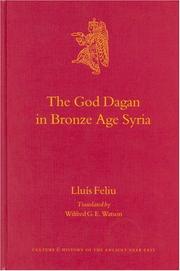
ISBN: 9004131582 9004496319 Year: 2003 Publisher: Leiden Brill
Abstract | Keywords | Export | Availability | Bookmark
 Loading...
Loading...Choose an application
- Reference Manager
- EndNote
- RefWorks (Direct export to RefWorks)
Bronze age --- Dagan (Semitic deity) --- Syria --- Religion.
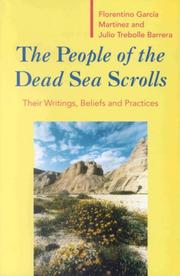
ISBN: 9004100857 9004664343 Year: 1995 Publisher: Leiden ; New York ; Cologne Brill
Abstract | Keywords | Export | Availability | Bookmark
 Loading...
Loading...Choose an application
- Reference Manager
- EndNote
- RefWorks (Direct export to RefWorks)
This book, written jointly by two distinguished Qumran scholars, attempts to provide answers to some important questions that have been discussed recently in media reports on the Dead Sea Scrolls, such as: have certain manuscripts been suppressed?; do the manuscripts question substantial aspects of the Jewish and Christian traditions?; do the roots of Early Christianity derive from the Essene movement?; and more. This volume offers solid and up-to-date information on the literary heritage, the social organization and the religious beliefs of the Qumran community and its links with Early Christianity. It gives the reader an opportunity to look behind the scenes of the research of the Dead Sea texts and the ongoing scholarly debate on the origins of the Essene movement and the Qumran sect.
Bible --- Jewish religion --- Essenen --- Essenes --- Esséniens --- Qumran (Communauté) --- Qumran community --- Qumrangemeenschap --- 229*3 --- Christianity --- -Essenes --- Kumran community --- Jewish sects --- Religions --- Church history --- Dode Zeerollen en intertestamentaire literatuur --- Origin --- 229*3 Dode Zeerollen en intertestamentaire literatuur --- Church --- Foundation --- Dead Sea scrolls. --- Jerusalem scrolls --- ʻAin Fashka scrolls --- Jericho scrolls --- Scrolls, Dead Sea --- Qumrân scrolls --- Rękopisy z Qumran --- Shikai bunsho --- Megilot Midbar Yehudah --- Dodezee-rollen --- Kumránské rukopisy --- Documentos de Qumrán --- Textos de Qumrán --- Rollos del Mar Muerto --- Manuscritos del Mar Muerto --- Manuscrits de la mer Morte --- Dödahavsrullarna --- Kumranin kirjoitukset --- Kuolleenmeren kirjoitukset --- Qumranhandskrifterna --- Qumranin kirjoitukset --- Qumran Caves scrolls --- Dead Sea Scrolls --- Criticism, interpretation, etc
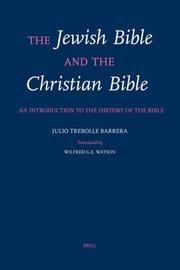
ISBN: 1281925683 9786611925680 9047427165 9789047427162 9781281925688 9004108882 9789004108882 9004108890 9789004108899 0802838308 9780802838308 0802844731 9780802844736 Year: 1998 Publisher: Leiden ; New York : Grand Rapids, Mich. : Brill ; Eerdmans,
Abstract | Keywords | Export | Availability | Bookmark
 Loading...
Loading...Choose an application
- Reference Manager
- EndNote
- RefWorks (Direct export to RefWorks)
Presents an overview of our knowledge on the history of the Bible. This book is divided into three parts, which shows how the collections of canonical and apocryphal books were formed and explains the transmission and translation of the Bible.
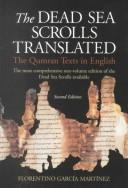
ISBN: 9004105891 0802841937 9004663118 Year: 1996 Publisher: Leiden : Grand Rapids, MI : E.J. Brill, William B. Eerdmans,
Abstract | Keywords | Export | Availability | Bookmark
 Loading...
Loading...Choose an application
- Reference Manager
- EndNote
- RefWorks (Direct export to RefWorks)
Book
ISBN: 9789004288645 9789004289574 9789004289581 9789004288652 9004288651 9004288643 1322984905 Year: 2015 Volume: 112 Publisher: Brill
Abstract | Keywords | Export | Availability | Bookmark
 Loading...
Loading...Choose an application
- Reference Manager
- EndNote
- RefWorks (Direct export to RefWorks)
As with any dictionary of a newly discovered dead language, the aim of this Dictionary of the Ugaritic alphabetic texts is to indicate the stage reached in its lexical description and to serve as a reference work for further study. In this connection, the main interpretative opinions have been included, since to a large extent Ugaritic lexicography remains uncertain. Also the most relevant comparative Semitic material has been provided in order to corroborate the lexical choices adopted by the authors and help readers to verify their own. The new material discovered since 1992 and recently published has also been included, along with all the personal and topographical names as in the two previous editions.
Ugaritic language --- Ougaritique (Langue) --- Dictionaries --- English. --- Dictionnaires anglais --- Semitic languages, Northwest
Book
ISBN: 9783868350685 3868350683 Year: 2012 Publisher: Münster : Ugarit-Verlag,
Abstract | Keywords | Export | Availability | Bookmark
 Loading...
Loading...Choose an application
- Reference Manager
- EndNote
- RefWorks (Direct export to RefWorks)
Assyriology. --- Semitic languages. --- Assyriologie --- Langues sémitiques --- Watson, Wilfred G. E. --- Ugarit (Extinct city) --- Ougarit (Ville ancienne) --- Festschrift - Libri Amicorum --- Langues sémitiques --- Assyriology --- Semitic languages --- Afroasiatic languages --- Assyro-Babylonian studies --- Ougarit (Extinct city) --- Raʼs Shamrah (Syria) --- Ras Shamra (Syria) --- Ugarit (Ancient city) --- Syria --- Antiquities
| Listing 1 - 10 of 10 |
Sort by
|

 Search
Search Feedback
Feedback About UniCat
About UniCat  Help
Help News
News